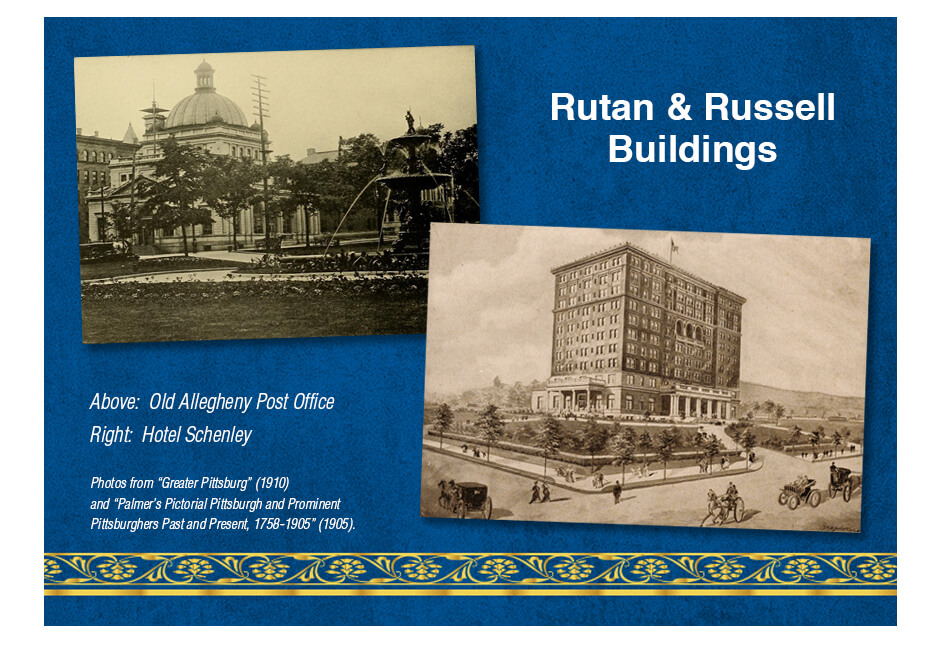Frank E. Rutan

1861-1911
Born in Newark, New Jersey, architect Frank E. Rutan was a partner in the firm Rutan & Russell, which designed several significant buildings in Pittsburgh in the 1890s and early 1900s. Rutan opened a savings account at Dollar Bank in April 1900, in trust for his one-year-old son, Frank E. Rutan, Jr.
Early in his career, Rutan worked for celebrated architect H.H. Richardson in Boston and at Shepley, Rutan and Coolidge, the architectural firm in which his brother, Charles, was a partner. Frank Rutan was sent to Pittsburgh in 1886 to complete the construction of the Allegheny County Court House, designed by H.H. Richardson in his signature architectural style, Richardsonian Romanesque. Rutan soon worked for another firm in Pittsburgh, Longfellow, Alden & Harlow, then became the Pittsburgh representative of his brother’s firm.
When the Pittsburgh office of Shepley, Rutan & Coolidge closed in early 1896, Rutan formed his own firm with fellow architect Frederick Russell, a colleague he had worked alongside going back to their days at H.H. Richardson's firm in Massachusetts. Fewer than two years later, the partners embarked on one of their most significant projects, the construction of Hotel Schenley. Completed in 1898, the posh hotel overlooked Schenley Park and became a favorite destination for distinguished visitors to Pittsburgh. Important guests included Presidents Theodore Roosevelt, Woodrow Wilson and Dwight D. Eisenhower, movie stars Katharine Hepburn and Spencer Tracy, and baseball legends Babe Ruth and Ty Cobb. In the 1950s, the hotel was sold to the University of Pittsburgh and became repurposed as the William Pitt Union.
Rutan & Russell also designed St. Augustine's Roman Catholic Church in Lawrenceville, as well as residences for T.H.B. McKnight in Sewickley, Charles H. Bradley, Jr. on Morewood Place in Pittsburgh's East End, and B.F. Jones, Jr. on Ridge Avenue on the North Side. The B.F. Jones house serves as Jones Hall for Community College of Allegheny County's North Side campus and is a City of Pittsburgh Historical Structure and a Pittsburgh Landmark with the Pittsburgh History and Landmarks Foundation. Rutan & Russell's Allegheny Post Office, a Renaissance Revival Style building completed in 1897, was listed on the U.S. National Register of Historic Places in 1971 and became home to the Children's Museum of Pittsburgh in 1983.

In 1896, Frank E. Rutan married Martha Fleming in a large wedding at “The Maples,” the Fleming family home in Sewickley. It was an advantageous match for Rutan. His bride, Martha, was the daughter of a successful druggist, Joseph Fleming, and the sister of First Ward Councilman George S. Fleming. Martha's sister Annie was married to Sewickley resident Frank E. Richardson, president of Pittsburgh Forge and Iron Company and future director of the Sewickley Valley Trust Company. The Rutans made their home on Academy Avenue in Sewickley.
Rutan was active in the local professional architectural community as a co-founder of the Pittsburgh Architectural Club. He also served as a judge for exhibitions hosted by the Club. At Sewickley Presbyterian Church, he was the leader of a choral society, the Monday Night Club. He was also a member of the Duquesne Club and the Allegheny County and Edgeworth Country Clubs.
Rutan died in February 1911 in Atlantic City, New Jersey, where he was on vacation with his wife, three children, and architect partner Frederick Russell. He was interred in Sewickley Cemetery after memorial services conducted by the pastor of Sewickley Presbyterian Church. His son, Frank E. Rutan, Jr., served in World War I and founded a successful metal products firm in Philadelphia.
